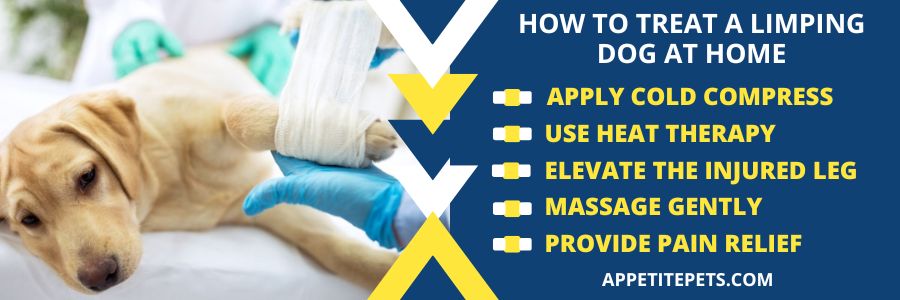How to Treat a Limping Dog at Home: A Comprehensive Guide
Learn how to treat a limping dog at home with these expert tips and techniques. Seeing your beloved canine friend limping can be distressing.
However, if you give them your full attention and care, you can ease their suffering and speed up their recovery. Detailed information is provided below.
Observe Your Dog’s Behavior
Observing the dog’s behavior is the first stage of caring for a limping dog at home. Keep an eye on your dog’s gait to see if they are favoring one leg or showing any signs of discomfort.
This will let you know if your dog needs emergency medical care and the extent of the injury.
Treatment Options:
Possible treatments change depending on the underlying cause. Limit your dog’s activity and give him plenty of time to rest. Use whatever method works best for you: ice packs, bandages, or heating pads.
Consult a vet before giving an over-the-counter pain medication.
Rest
A dog with a limp needs to rest. Provide your dog with a warm, cozy place to rest, and refrain from doing anything that could put additional stress on the injured leg.
Your dog’s body will be able to concentrate on healing the injured area.
Apply Cold Compress
Putting a cold compress on the area where the limping is happening can help reduce swelling and inflammation if an injury is to blame.
For this, you can use a cold pack or a bag of frozen vegetables wrapped in a towel. A cold compress should be used for 10 to 15 minutes, multiple times a day.
Use Heat Therapy
If arthritis is to blame for the limping, heat therapy may help alleviate the pain. A heating pad or a warm towel would work well for this. It is recommended that heat therapy be used for 10–15 minutes at a time, multiple times daily.
Elevate the Injured Leg
The swelling and pain in an injured leg can be alleviated by elevating the leg. Raise the injured leg above the level of the heart by placing a pillow or cushion under it.
In addition to making your dog more at ease, this will also benefit his health.
Massage Gently
Reducing stiffness and increasing blood flow to the injured area are one of the benefits of massage therapy. Avoid putting any weight on the injured leg and treat it with care. Try massaging for a few minutes multiple times a day.
Provide Pain Relief
Pain medication, such as aspirin, can be given to a dog if you notice that it is suffering. A trip to the vet is recommended before giving your dog any medication. Some medications have serious side effects that can be fatal for dogs.
Keep Your Dog’s Weight in Check
Your dog’s limp may be caused, or made worse, by his or her weight. Your dog needs to get plenty of exercises and stay at a healthy weight.
Consult With Your Veterinarian
Talk to your vet if your dog’s limping lasts more than a few days or seems to be getting worse. Your vet can examine your dog, take X-rays if necessary, and advise you on the best course of treatment.
Prevention Tips:
Prevent future occurrences by sticking to a healthy diet, regular exercise, and neat personal hygiene. Always wear protective gear when going outside to play or walk your dog.
It’s important to keep a close eye on your dog’s demeanor and look for any signs of distress on a regular basis.
FAQs:
Q: How long does it take for a limping dog to recover?
A: The recovery time varies depending on the severity of the injury or illness. Consult with a veterinarian for a more accurate estimate.
Q: Can a dog limp heal on its own?
A: It depends on the underlying cause of the limp. Some minor injuries may heal on their own with rest and time, while others require medical attention.
Q: What can I give my dog for limping?
Ask your vet for advice before giving your dog any medication for limping. Depending on the root of the limp, the doctor may prescribe painkillers or recommend alternative therapies.

Q: How long does it take for a dog to heal from a limp?
A: Time to recovery from a limp is proportional to the nature and severity of the underlying injury or condition. It could take a few days for a minor injury to heal, but it could take weeks or months for a more serious one.
Q: Why would a dog suddenly start limping?
A: Many different things, like trauma, arthritis, strained muscles, ligaments, or a broken bone, can cause a dog to suddenly start limping. Finding the root of the problem and getting treatment from a vet are both crucial.
Q: Can a limp go away naturally?
A: When the underlying cause is addressed, a limp sometimes disappears on its own. It is important to determine the root of the problem and treat it accordingly to avoid any further complications.
Q: Is limp curable?
A: The curability of a limp depends on the underlying cause. Some minor injuries or conditions may be curable with appropriate treatment, while more severe or chronic conditions may require ongoing management and care.
Q: Can I give my dog human pain medication for their limping?
A: No, it’s not recommended to give human pain medications to dogs without consulting a veterinarian first.
Q: Can limping be a sign of a more severe underlying condition?
A: Yes, limping can be a sign of a more severe underlying condition, such as arthritis or a fracture. Consult with a veterinarian for proper diagnosis and treatment.
Conclusion:
It takes time, effort, and careful attention to detail to treat a limping dog at home. If you use the advice given above, you should be able to get your furry friend well on the road to recovery and back to their old, energetic self in no time. Always seek the advice of a vet for an accurate diagnosis and treatment.




